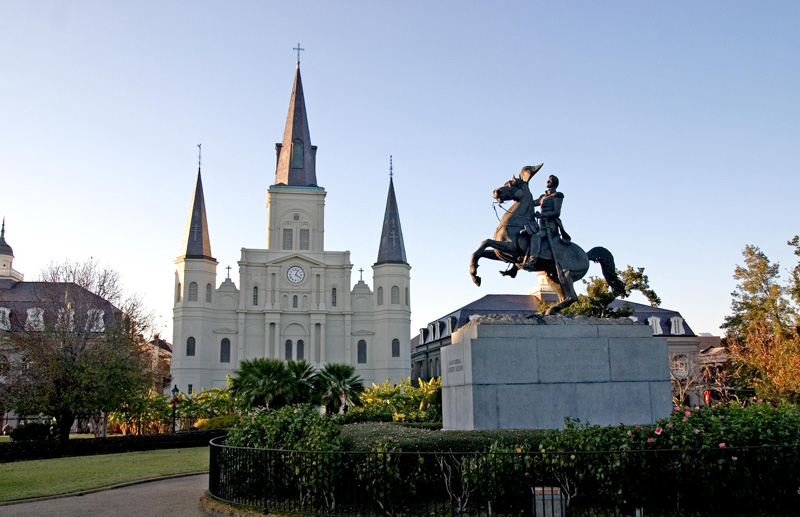
(by Gretchen R. Crowe, OSV Newsweekly) Ready for some Catholic sightseeing? Based on culture, history, physical landscape and spirituality, the following list of Top 10 U.S. Catholic Cities — listed in no particular order — highlights American hubs with a Catholic pulse. Each location, whether it be large or small, east or west, contributes to the richness of Catholic life in America.
Should these locations be next door, across the state or across the country, OSV Newsweekly hopes this list will prove useful and inspiring when it comes to incorporating the Faith into your travel plans this summer.
New Orleans
From its earliest moments, when Robert Cavelier de la Salle arrived in the Mississippi Valley and claimed the land for God (and King Louis XIV), the area that would become the city of New Orleans had a Catholic heart. With its “parishes,” saint-named streets, more than 40 Catholic churches and rich Catholic culture, New Orleans is a quintessential U.S. Catholic city.
The roots of New Orleans Catholicism took hold in 1699, when Father Anastase Douay celebrated the first recorded Mass on Louisiana soil near the mouth of the Mississippi on Mardi Gras. Since then, worshippers have gathered regularly — most consistently and notably at the Cathedral of St. Louis in Jackson Square.
Originally built in 1789 but greatly rebuilt in 1850, this grand cathedral sits on the site where worshippers have gathered since the earliest colonial churches in 1727. The sacred space, considered the oldest continuously functioning cathedral in the United States, houses a monument honoring Venerable Henriette DeLille, known as the “servant of slaves,” who founded the Sisters of the Holy Family still present in New Orleans.
Three shrines are worth a look when visiting New Orleans. The National Shrine of Blessed Francis Xavier Seelos is located inside St. Mary’s Assumption Church, and it includes the tomb containing his relics, a museum and a gift shop. The National Shrine of Our Lady of Prompt Succor, patroness of New Orleans who is believed to have helped the city defend itself against a British attack in the 1815 Battle of New Orleans, is located on State Street, on the same grounds as the Ursuline Academy and residence of the Ursuline Sisters of the Roman Union. Also noteworthy is the International Shrine of St. Jude.
In October 2004, New Orleans opened the Catholic Cultural Heritage Center, which includes a museum at the Old Ursuline Convent — built in 1752-53 and considered the oldest building in the Mississippi Valley still standing — and St. Louis Cathedral.
New Orleans also was home to the first Catholic hospital in the United States, Hotel Dieu, operated by the Daughters of Charity.
New Orleans facts
Founded: 1718
Population: 369,250 for city, 1.23 million for metro area
Did you know?: Although known as the birthplace of jazz and blues, New Orleans was also the site of the first opera performance in the United States back in 1796.
Emmitsburg, Md.
Located at the base of the Catoctin Mountains in Maryland, the town of Emmitsburg could be considered the seat of American Catholicism. It was in Emmitsburg where St. Elizabeth Ann Seton, the first native-born American saint, and her three daughters arrived in 1809 from Baltimore. It was there where Mother Seton established the Sisters of Charity of St. Joseph, the first congregation of religious sisters to be founded in the United States that turned into the basis for several more religious orders. And it’s there where she is buried at the National Shrine of St. Elizabeth Ann Seton.
Emmitsburg
National Shrine of St. Elizabeth Ann Seton. CNS photo
Notable sites at the shrine include the Stone House — originally built in 1750, it later housed the first headquarters for the Sisters of Charity; the White House, a one-room school built in 1810; and a cemetery, basilica and chapel tomb where Mother Seton often prayed.
Two miles south of the national shrine, off Route 15, is Mount St. Mary’s University and Seminary, where many priests are formed. On campus is the National Shrine Grotto of Our Lady of Lourdes, the oldest known replica of the beloved French site.
Emmitsburg also was home to St. Joseph College (originally St. Joseph Academy), which was founded by the Sisters of Charity of St. Joseph in 1809 and closed in 1973.
In 1812, Emmitsburg became the home of Father Simon William Gabriel Bruté de Remur who taught and ministered to the community so effectively at Mount St. Mary’s that he was nicknamed “Angel of the Mount.” He also served as Mother Seton’s spiritual adviser.
Father Bruté stayed in Emmitsburg until 1834, when he was appointed bishop of the new Diocese of Vincennes, Ind. The cause for Father Bruté’s canonization was opened in the fall of 2005, and he is now known as Servant of God. Mother Seton was canonized in 1975 by Pope Paul VI.
Emmitsburg, Md. facts
Founded: 1785
Population: 2,852
Did you know?: Emmitsburg is located just 10 miles south of Gettysburg, Pa., site of the largest Civil War battle.
Bethlehem, Conn.
Settled 100 miles northeast of New York City, the town of Bethlehem, Conn., might seem like a strange pick for a top U.S. Catholic city. But the presence of the Abbey of Regina Laudis lends Bethlehem and the surrounding area an undeniable aura of Catholic culture. Founded in 1947, the abbey houses a community of contemplative Benedictine women who are, according to its website, “dedicated to the praise of God through prayer and work.” The nuns and other volunteers work the 450 acres of land, yielding an array of products ranging from pottery and candles to honey, vinegar and perfume.
Regina Laudis
Vespers at the Abbey of Regina Laudis. Photo by Donna-Marie Cooper O’Boyle
While not every part of the abbey is open to the public, visitors are welcome to the Abbey Church Jesu Fili Mariae, the Lower Monastery Chapel, the Monastic Art Shop, and the 18th-century Neapolitan Crèche, which is believed to have been made for Victor Amadeus II, the king of Sardinia, for his coronation. Beautiful hand-carved Stations of the Cross, carved out of a cherry tree by Abbey artist Reverend Mother Placid Dempsey, line the walls of the Lower Monastery Chapel.
Mother Dolores Hart, former actress and author of the recent autobiography “The Ear of the Heart: An Actress’ Journey from Hollywood to Holy Vows,” serves as prioress of the abbey. Maybe it’s her Hollywood background or the nuns’ long-standing tradition of Gregorian chant, but the arts thrive at Regina Laudis. The abbey has appeared in two documentary productions: “God is the Bigger Elvis,” based on Mother Dolores, and “The Cheese Nun,” on Mother Noella Marcellino. On abbey grounds sits The Gary-The Olivia Performing Arts Center, which sponsors an active local summer theater.
Located outside of Regina Laudis is Church of the Nativity, which was established as a mission church in 1884 to serve mostly immigrants including Canadians, Irish, Germans, Italians, and Eastern Europeans, especially Lithuanians. And one little piece of trivia: Thousands of visitors flock to Bethlehem in December to postmark their Christmas cards.
Bethlehem, Conn., facts
Founded: 1787
Population: 3,422
Did you know?: Bethlehem is believed to be the location of the 1949 movie “Come to the Stable,” starring Loretta Young and Celeste Holm, in which two French nuns come to America to found a children’s hospital.
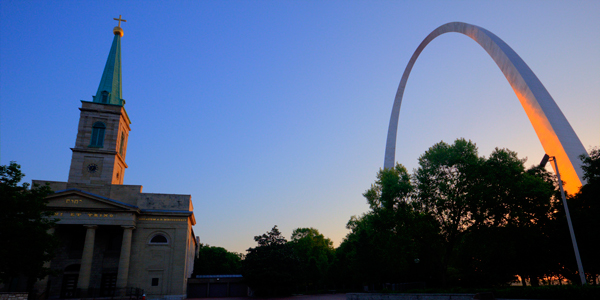
St. Louis
Known as “the Rome of the West” because of its rich Catholic history, St. Louis was pivotal in spreading Catholicism into the western half of the United States. Its “Old Cathedral,” the Basilica of St. Louis, King, was founded in 1770 and is the first Catholic cathedral west of the Mississippi River.
The “New Cathedral,” formally known as the Cathedral Basilica of St. Louis, is a sight to see in its own right with its Byzantine revival architecture and what is believed to be the largest collections of mosaics in North America. According to the cathedral’s website, these mosaics were designed “to remind all of us that God reaches into our earthly lives.”
St. Louis
Basilica of St. Louis, King, is also known as the “Old Cathedral.” Shutterstock
St. Louis also is home to the St. Patrick Center, an action-based service provider of housing, employment and health services for the homeless or those at risk for homelessness. The St. Patrick Center assists more than 9,000 people each year.
A shrine to St. Rose Philippine Duchesne — a French sister of the Sacred Heart who brought formalized Catholic education to Missouri in 1818 — is located on the outskirts of the city in St. Charles. Her school for girls was the foundation of not only the Academy of the Sacred Heart in St. Charles, but Catholic education as a whole in the Archdiocese of St. Louis.
St. Louis is the hometown of New York Cardinal Timothy M. Dolan, and has a long list of archbishops and cardinals to its name, including Cardinal John Carberry, who died in 1998, and Cardinal Raymond Leo Burke, in St. Louis from 2003 to 2008, who now serves as the prefect of the Supreme Tribunal of the Apostolic Signatura at the Vatican.
St. Louis also is home to the cloistered Holy Spirit Adoration Sisters (often called the “Pink Sisters” because of their rose-colored habits) at Mount Grace Convent, who have been in perpetual adoration since 1928 — a remarkable 85 years.
The adoration chapel is open to the public daily and identifies itself as a place “where heaven and earth meet in the heart of the Church and where prayer in the presence of the Blessed Sacrament is an oasis of peace for all who seek God.”
St. Louis facts
Founded: 1764
Population: 319,294, 1 million in St. Louis County
Did you know?: The National Shrine of Our Lady of the Snows, in nearby Belleville, Ill., is the largest outdoor shrine in the country.
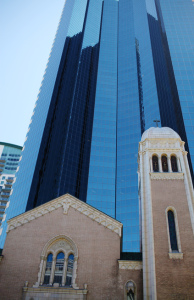 Denver
Denver
With a growing number of Catholic institutions present, Denver is fast becoming a major Catholic city. Much of the renewal of faith in the “Mile High City” can be traced to its being the site of World Youth Day in 1993.
During his World Youth Day visit, Blessed John Paul II celebrated Mass in downtown Denver at the Cathedral Basilica of the Immaculate Conception. That alone makes it a “must-see” site — but the cathedral is a masterpiece in its own right with its 210-foot spires, altar, statuary and bishop’s chair made out of Italian marble, and 75 stained-glass windows that hail from Munich. The cathedral was consecrated in 1921 and elevated to a minor basilica Dec. 25, 1989.
Denver
Denver’s Cathedral Basilica of the Immaculate Conception CNS photo
Also stemming from John Paul II’s 1993 visit is the St. Augustine Institute, a fast-growing Catholic graduate school that, according to its website, trains students “to proclaim the Gospel with ‘new ardor, method and expression’ as Blessed John Paul II insisted.”
Much of Denver’s Catholic activity centers on the John Paul II Center for the New Evangelization, a space that houses both the archdiocesan offices as well as St. John Vianney Theological Seminary, Redemptoris Mater seminary, the Religious Sisters of Mercy convent, an outdoor Stations of the Cross and a renowned Cardinal Stafford Library — not to mention large soccer and softball fields. Listed on the National Register of Historic Places, the center once was known as the St. Thomas Seminary; the name changed after World Youth Day.
A shrine to St. Frances Xavier Cabrini (though not the national one, which is in Chicago), is located just outside the city limits in Golden, Colo.
Denver’s surrounding environs also serve as home base for Catholic News Agency (Englewood, Colo.) and the Fellowship of Catholic University Students (Golden). The city will host the 2013 Catholic Media Convention in June.
Denver also has a large Hispanic population. Upon being named archbishop in 2012, Samuel J. Aquila said: “I entrust this new beginning to Our Lady of Guadalupe, who has always covered me with her mantle of love and protection.”
Denver facts
Founded: 1858
Population: 634,265 (for Denver County)
Did you know?: Margaret Tobin Brown, better known to the world as the Unsinkable Molly Brown, was a Denver resident who helped raise funds to build Denver’s Cathedral of the Immaculate Conception.
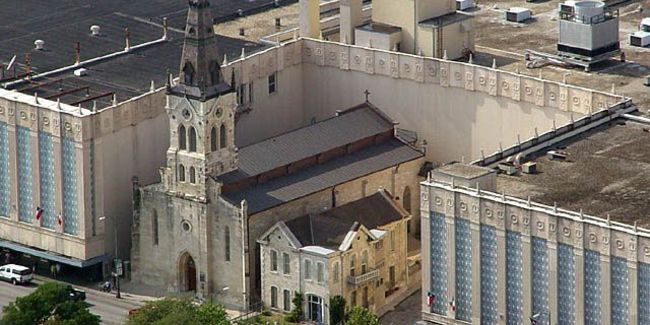
San Antonio
According to the Texas State Historical Association, the Catholic Church has been part of Texas history since 1528. The Catholic history and culture is so prevalent that the San Antonio Missions are considered a National Historical Park, which preserves four out of the five Spanish frontier missions in San Antonio. These locations were established to spread the Catholic Faith to Native Americans in early American history.
San Antonio
Mission San Jose is one of four San Antonio missions main- tained by the National Park Service. Shutterstock
The most popular, Mission San Antonio, was established in 1718 by Father Antonio Olivares and was later converted to the “Alamo,” a military fort that was sieged in 1836 (“Remember the Alamo!”). Visitors can take in the entire experience by driving, biking or walking down a 10-mile Mission Trail.
One of the most striking structures in San Antonio — and certainly the most historic — is the San Fernando Cathedral. Founded in 1731, it’s the “oldest, continuously functioning religious community in the state of Texas,” according to its website. It’s also the oldest standing church building in the state.
Also not to be missed is the grandiose Basilica of the National Shrine of the Little Flower, with marble altar, stained-glass windows and hand-carved Stations of the Cross. In true St. Thérèse style, roses, too, are in abundance.
San Antonio is also home to the Oblate School of Theology, run by the Missionary Oblates of Mary Immaculate, who arrived in Texas in 1849. The school forms both future priests and the laity for ministry in the Church.
One thing not to miss: the statue of St. Anthony of Padua on the city’s popular River Walk. The inscription reads: “San Antonio — for whom the city and the river are named — gift of Portugal.”
San Antonio facts
Founded: 1718
Population: 1.36 million
Did you know?: San Antonio was given its name on June 13, 1691 — the feast of St. Anthony of Padua — when a Spanish expedition, which included Father Damian Massanet, came upon the river and named it Rio San Antonio.
Chicago
Chicago’s Catholic heart is based in its ethnic diversity.
As the Windy City became industrialized in the mid-19th century, immigrants from Southern and Eastern Europe flocked to Chicago — joining the already present Irish and Germans — to become part of its workforce. Ethnic communities naturally formed, and ethnic Catholic parishes naturally followed. Today, more than 350 Catholic churches remain, many built in impressive European style.
Chicago
Monstrance at St. Stanislaus Kostka Church. Karen Callaway/Catholic New World
Three are designated basilicas by the Vatican: Our Lady of Sorrows Basilica in East Garfield Park (home to the National Shrines of Our Lady of Sorrows and St. Peregrine, patron saint of those suffering from cancer); Queen of All Saints Basilica in Forest Glen (the location of the signing of the Treaty of Chicago); and the Basilica of St. Hyacinth (with its 62 relics).
Always bustling is St. Peter’s in the Loop, with its seven weekday Masses and confessions every day but Sunday. Beautiful artwork can be found at St. Mary of the Angels Church in Bucktown and, for those with hopeless causes to unburden, a small National Shrine of St. Jude is located inside of Our Lady of Guadalupe Church on the South Side.
Also not to be missed is St. Stanislaus Kostka Parish, designated the Sanctuary of the Divine Mercy by Cardinal Francis George in 2007, and its iconic (and quite large) Our Lady of the Sign-Ark of Mercy monstrance.
Paying tribute to the many immigrants who make up the fabric of Chicago, the National Shrine of St. Frances Xavier Cabrini, patron saint of immigrants, also can be found in the Windy City and was renovated in 2012.
The archdiocese is also the home of Mundelein seminary, headed by Father Robert Barron. Chicago also is the hub of the Catholic Press Association, the Catholic Theological Union and the canonization cause for Servant of God Father Augustus Tolton.
It also was the location of the 28th International Eucharistic Congress in 1926 — the first such gathering held in the United States and an event that attracted cardinals and archbishops from around the world.
Chicago facts
Founded: 1833
Population: 2.7 million in city; 9.4 million in metro area
Did you know?: The first Ferris wheel was built on the midway of the 1893 World’s Columbian Exposition.
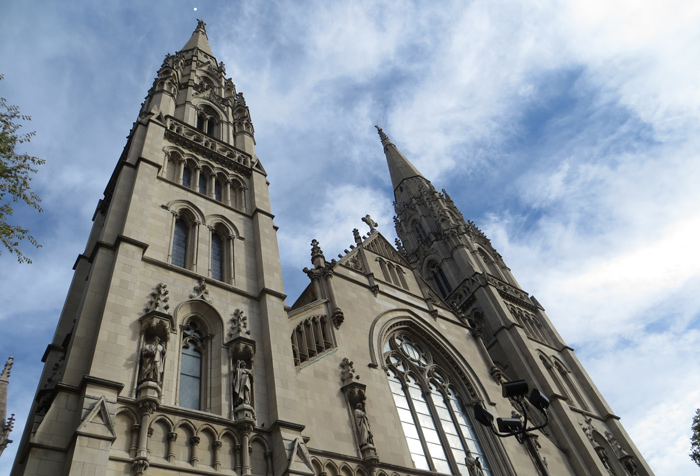
Pittsburgh, Pa.
The Church has a long history in the mountains of southern Pennsylvania. Jesuit Father Joseph Bonnechamps is believed to have celebrated the first sacraments in the area as he accompanied French-Canadian explorer Pierre-Joseph Céloron de Blainville along the Ohio and Allegheny rivers in 1749.
Now, Pittsburgh offers visitors a variety of beautiful churches in a diocese with more than 650,000 Catholics. St. Paul Cathedral, located in the Oakland neighborhood, is the diocesan mother church and, according to its website, “stands and shines as a beacon of hope.” For a healthy dose of art, visit St. Nicholas Parish and take in its walls and ceilings covered in murals, including one depicting Croatian peasants in native dress praying the Angelus. Also nearby is St. Paul of the Cross Monastery, the U.S. motherhouse of the Passionist religious order, who have been in Pittsburgh since 1852. The monastery offers a rich history, a peaceful facility and an opportunity for retreat.
Pittsburgh
St. Anthony’s Chapel contains more than 5,000 relics. Shutterstock
If relics are your cup of tea, you won’t want to miss St. Anthony’s Chapel, which touts the largest public collection of relics in the world. Located on Troy Hill and overlooking the Allegheny River, the chapel contains more than 5,000 relics, including a piece of Jesus’ crown of thorns and a portion of St. Joseph’s cloak.
The Pittsburgh Oratory of St. Philip Neri, located within walking distance of St. Paul, runs the Ryan Catholic Newman Center for the University of Pittsburgh. It offers perpetual Eucharistic adoration and is active in reaching out to young people on college campuses. Also affiliated with John Henry Newman is the National Institute for Newman Studies, a study and research institute developed to bring Newman’s teachings to today’s society.
The diocese boasts a long line of prelates with strong ties to the Steel City, including Cardinal Donald Wuerl of Washington, D.C.; Cardinal Sean O’Malley of Boston; and Cardinal Daniel DiNardo of Galveston-Houston.
Also noteworthy is that Pittsburgh is the seat of the Byzantine Catholic Archeparchy of Pittsburgh, which governs all Byzantine Catholic churches in the United States. At the archeparchy’s center is St. John the Baptist Byzantine Catholic Cathedral, filled in typical Byzantine style with rich-colored iconography. The archeparchy also operates Sts. Cyril & Methodius Byzantine Catholic Seminary, which prepares priests for all Byzantine Catholic eparchies in North America.
Pittsburgh facts
Founded: 1758
Population: 307,484 in the city, 2.36 million in the metro area
Did you know?: Pittsburgh has 446 bridges — three more than Venice, Italy.
St. Augustine, Fla.
The beautiful coastal town of St. Augustine, Fla., offers a rich Catholic history, in addition to its patron saint-inspired name. According to the National Historic Landmarks program, St. Augustine, founded in 1565 by Spanish settlers, is “the oldest continuously occupied European settlement in the continental United States.” The first Mass was celebrated by Father López de Mendoza Grajales on Sept. 8, 1565, the day the Spanish ship arrived in the New World. A result of that settlement was its oldest parish: now the Cathedral Basilica of St. Augustine. Renovated in 1965-66, the cathedral, with its ornate exposed bell tower, was raised to the dignity of a minor basilica on Dec. 4, 1976.
St. Augustine
Mission of Nombre de Dios is located on the site of the first Mass in St. Augustine. Shutterstock
A natural vacation destination with its cobblestone streets and oceanfront view, St. Augustine also offers a place of spiritual renewal. The Mission of Nombre de Dios, and its accompanying Shrine of Our Lady of La Leche, is located steps from the arterial waterways that lead to the Atlantic Ocean. The mission was established on the land where, according to its website, Father López celebrated the first Mass (an 11-foot statue of the priest stands adjacent to a nearby lagoon).
Also part of the mission are Prince of Peace Church and “The Great Cross,” both built to commemorate the mission’s (and city’s) quadricentennial in 1965. The cross is 208 feet tall, weighs 70 tons and is made of 200 stainless steel panels.
In the center of the mission grounds is the chapel dedicated to Our Lady of La Leche, the first shrine dedicated to the Blessed Mother in the United States. Established in 1615, Our Lady of La Leche (Our Lady of the Milk) is a popular destination for mothers to ask God to grant them a safe delivery and happy, healthy children.
St. Augustine facts
Founded: 1565
Population: 13,336
Did you know?: In 1887, Henry Flagler began work on three hotels in the hopes of turning St. Augustine into a winter resort for the rich. One of the hotels is the centerpiece of Flagler College.
Los Angeles
It might be best known for Hollywood, movie stars and Sunset Boulevard, but the City of Angels, home to 4.2 million Catholics (in the diocese), has a rich Catholic history dating back to the settlement of Spanish missions by Franciscan friars along California’s coast.
Los Angeles
Cathedral of Our Lady of the Angels. Gerry Boughan/Shutterstock.com
San Gabriel Arcángel Mission, founded Sept. 8, 1771, by Father Pedro Cambón and Father Angel Somera, was the original mother church of Los Angeles County. The original altar was handmade in Mexico City, and surrounding wooden statues were carved in Spain.
Just to the north of the city is Mission San Fernando Rey de Espana, founded in 1797. Not to miss there is the elaborately carved altar, reredos and pulpit — handmade out of walnut. These pieces originally were installed in the chapel of St. Philip Neri in Spain, then were reassembled for use at San Fernando. The mission also is home to the Bob Hope Memorial Garden, the final resting place of the comedian and Catholic convert.
Juxtaposed with the traditional architecture of the missions, the Cathedral of Our Lady of the Angels, the mother church of Los Angeles, is a massive, modern structure completed in 2002 to accommodate more than 3,000 worshippers.
The cathedral was built in place of more historic St. Vibiana’s Cathedral, which closed in 1995 due to earthquake damage. The new cathedral is a permanent home to a piece of St. Juan Diego’s tilma with the image of Our Lady of Guadalupe upon it, as well as the largest collection of tapestries hanging in a Catholic church in the United States.
Two other places of interest: the Monastery of the Angels just north of Hollywood, renowned for its homemade goodies; and the Church of the Good Shepherd in Hollywood, the oldest church in Beverly Hills. The church appeared in several movies, was the site of Gary Cooper’s conversion, and hosted Frank Sinatra’s funeral.
Los Angeles facts
Founded: 1781
Population: 3.82 million, 9.96 for Los Angeles County
Did you know?: Historians disagree on the first name. Some say it’s El Pueblo de Nuestra Señora la Reina de los Angeles (“Town of Our Lady, Queen of the Angels”). Others say it’s El Pueblo de Nuestra Senora de los Angeles de Porciuncula (“Town of Our Lady of the Angels of Porciuncula”).
Gretchen R. Crowe is the editor of OSV Newsweekly.



